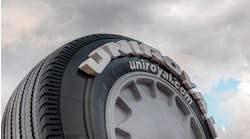Bridgestone Americas Holding Inc. recently filed a complaint against Michelin North America Inc. with the National Advertising Division (NAD) of the Council of Better Business Bureaus.
As a result, NAD, the advertising industry's self-regulatory forum, has recommended that Michelin "modify" the disclosures in question and "discontinue" certain advertising claims.
Bridgestone challenged the following advertising claims/statements made by Michelin about its fuel-efficient tires:
* "It's time to fight back. Michelin fuel-efficient, long-lasting tires help you save money."
* "Michelin makes the most fuel-efficient line of tires on the road, which saves you money over the life of your tires."
* "About $300 or 68 gallons of gas -- that's what a set of Michelin Latitude Tour HP tires can save you."
* "About $200 or 51 gallons of gas -- that's what a set of Michelin Primacy MXV4 tires can save you. "
* "Rolling resistance testing based on SAE J1269 Industry Practice. Michelin Latitude Tour HP 255/55R18 105H compared to Bridgestone Dueler H/L Alenza 255/55R18 109H. Michelin Primacy MXV4 215/50R17 91V compared to Bridgestone Turanza with Serenity Technology 215/50R17 95V. Calculated fuel/cost savings are approximate estimations based on several variables, not precise measurements; vehicles equipped with four Michelin brand tires; and fuel at $4 per gallon."
The focus of the challenged advertisement and the examination by NAD was the impact of the advertiser's tires on vehicle fuel efficiency, and their ability to save consumers money "at the pump."
As a preliminary matter, NAD said it "recognized that rolling resistance -- or a tire's drag on the roadway -- is the main source of the tire's influence on fuel consumption, and that there is a well-established and verifiable relationship between tire rolling resistance and vehicle fuel economy."
However, the heart of the issue presented "was not whether rolling resistance is an appropriate measure of a tire's contribution to vehicle fuel economy, but rather the message or messages conveyed by the advertising, and whether the advertiser's evidence is sufficient to support those messages."
1. NAD determined that the challenged advertisement refers to the Michelin line of tires as a whole.
"Although the advertisement does refer to two specific tire models," it said, "nothing in the advertisement limits the 'most fuel efficient line of tires' claim to a specific group of tires, nor does the advertisement inform consumers that this claim is based upon an average of its tires' rolling resistance scores."
NAD concluded that theses claims could be reasonably understood by consumers to mean that they can expect that each of the tires in the Michelin line is the "most fuel efficient" in comparison to competing tires. (By NAD definition, an advertiser must produce evidence demonstrating that all of the products in the line will perform as promised in order to substantiate a line claim.)
"The evidence in the record demonstrated that Michelin has the most fuel efficient tire in 20 of the 37 categories tested," said NAD. "Such evidence, however, was insufficient to support the product line claim at issue."
2. NAD determined that, with respect to the savings claims, the challenged advertisement was likely to be understood by consumers to mean that the advertised savings reflected "on the road" savings that consumers could typically achieve if they purchased Michelin tires.
Following its determination, NAD recommended that Michelin discontinue its use of the phrase "on the road" in order to avoid conveying the unsupported message that the advertiser's cost savings claims are based upon real-world or "on the road" consumer experiences.
3. NAD further determined that advertiser's disclosure regarding rolling resistance was insufficient to inform consumers about the basis of Michelin's cost-savings claims.
In particular, NAD determined that the statement "Calculated fuel/cost savings are approximate estimations based on several variables, not precise measurements" was too vague to provide the consumer with a clear understanding of how the cost savings were calculated.
"Given the small type, its placement within the print ad, and the language used... the disclosure was not adequately clear and conspicuous, as required by law," said NAD, which recommended Michelin modify its advertising "to more clearly reflect the basis of its cost savings claims, and make future disclosures more prominent so that all qualifying information is clear and conspicuous to consumers."
Gven the variability of fuel costs, NAD also recommended that Michelin include the dollar-per-gallon cost basis in the main claim, rather than as part of the disclosure.
In response to the recommendations, Michelin had this to say:
"At Michelin, we place an emphasis on respect for the facts, and these advertisements are no exception. It is important to note that through the NAD's decision, Michelin has been encouraged to modestly modify verbiage in its advertising claims, but received favorable mention for the credibility of its data."
According to Michelin, NAD referred to Michelin's supporting data as "impressive" -- the most
fuel efficient tire in an "impressive" 20 out of 37 categories tested.
"The NAD also recognized that 'rolling resistance is... the main source of the tire's influence on fuel consumption, and that there is a well-established and verifiable relationship between tire rolling resistance and vehicle fuel economy.' The NAD did not contest the quality or safety of Michelin's products, nor the sufficiency or credibility of Michelin's data/testing/formulas supporting the claims at issue.
"Michelin respects the NAD's self-regulatory process, and will take the decision under advisement in creating future marketing pieces that address the fuel-efficient attributes of Michelin tires."
NAD's inquiry was conducted under NAD/CARU/NARB Procedures for the Voluntary Self-Regulation of National Advertising. Details of the initial inquiry, NAD's decision, and the advertiser's response will be included in the next NAD/CARU Case Report.

